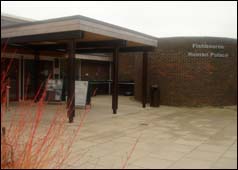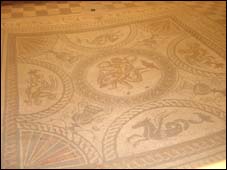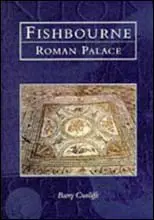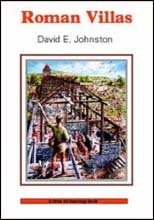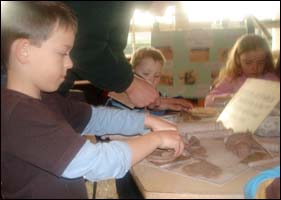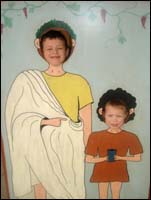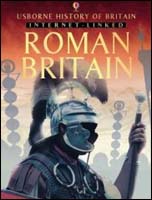|
Fishbourne Museum Palace
|
||||||||||||||||||
|
Wikipedia: Although local people had known of the existence of Roman remains in the area, it was not until 1960 that the archaeologist Barry Cunliffe first systematically excavated the site, which had been accidentally uncovered by workmen when a water main was being laid. The Roman villa excavated by Cunliffe's team was so large that it became known as Fishbourne Roman Palace, and a museum was erected to protect and preserve some of the remains in situ. This is administered by the Sussex Archaeological Society. Although due to new finds, there are new theories arising to what may have been built here. Romans
in Britain: This was the biggest single building ever found in Britain,
covering an area the size of Buckingham Palace in London. This was no
ordinary home, it had been built around 80-90AD by someone who was obviously
a person of authority.
Archaeological Information The Heritage Trail: Today, it is only the surviving north wing that can be seen, and this is protected by a permanent, covered viewing building. The collection of mosaics in this wing is quite extensive, and the near-complete 'Cupid on a Dolphin' containing some 360,000 tesserae is a remarkable piece of art. Outside, the northern half of the formal garden, complete with its decorative hedgerow flanking the entrance drive, has been re-created, and it is from the gardens that one can really appreciate the vast area that Fishbourne Roman Palace once occupied.
Roman Britain: Given the proximity of the inscribed Chichester stone to the villa at Fishbourne, the opulence of the villa itself, which boasted fine marble transported all the way from Greece and Italy, the testimony of the great historian Tacitus confirming his name and client-status, and also the coinage in the south of England, it is not outside the realms of possibility that the Fishbourne palace was indeed, the residence of the 'Great King of Britain', Cogidubnus of the Atrebates. The
palace is believed to be the home of Tiberius Claudius Togidubnus, the
client king of the Atrebates Regnenses who governed, on behalf of Rome,
from Noviomagus Reginorum, ‘New Market of the Proud Ones’,
now known as Chichester. Evidence suggests that he controlled the whole
of Britain South of the Thames, this included part of Dorset, Hampshire
and Surrey, and the whole of Kent and Sussex. He is also the only known
Britain to be made a member of the senate. The palace was built between
75 and 80 AD on the site of a Roman military complex. Felbridge
History Group YouTube - Fishbourne Roman Palace School Resources Sussex
Past: Fishbourne Museum Palace offers: Schools Education, Direct
teaching services for schools, Primary school education service, Printed/audio-visual
information and Secondary school education service. Sussex Past: Education is a primary role of the Roman Palace. There is a comprehensive education programme with a special emphasis on school groups. There are also new workshops to embellish the AS archaeology certificate taken by 16+ age group. During school holidays there is an opportunity for adults to take part in workshops such as Roman Textiles spinning, weaving and dyeing: Ceramics bonfire kilns, coiling, press moulding and the potters wheel: Making Mosaics design, plan and create a beautiful mosaic: Roman Plants and Gardens some of the mysteries of the plants and their uses will be revealed.
"In the Roman period, it is unlikely that ocean-going vessels could have reached Fishbourne Palace. The implication is that there could have been a Roman harbour at or near Copperas Point where goods for the Palace and beyond could have been offloaded." Chichester Harbour Conservancy Fishbourne Museum for Children Young Archaeologist: When you think of archaeology, most people think of buried treasures or lost cities, and yes some archaeologists have discovered these things. But archaeology isn't about fame and fortune. It is a way of learning about people who lived in the past, where they lived, what they ate, what they believed and the effects they had on the environment. Archaeologists study these by looking at the physical remains left behind by these people. The evidence can include artefacts (an artefact is a man-made movable object) such as pottery, tools or jewellery which can be made from materials like clay, bone, stone, wood or metal. Fixtures, such as evidence for site occupation, standing buildings or the remains of buildings that have later been buried underground, evidence of farming, and environmental remains such as plant remains.
Articles
Artefacts Stolen from Fishbourne Roman Palace: Pasthorizons Roman HQ `later became a guardhouse': British Archaeology The
Roman Invasion of Britain by Neil Grant THE BIG DIG: Barcombe Roman Villa The Use and Reuse of Building Materials in the Archaeological Record by Emeritus Professor Windsor
The discovery of Fishbourne Roman Palace (Chichester, West Sussex) in the 1960s recovered the plan, and much detail, of one of the most remarkable buildings in Roman Britain. The extent of the excavations could only reveal glimpses of earlier phases of development in the Roman period beneath the Palace, and subsequent excavations, up until 2002, have added additional detail. English Heritage
Forums
|

